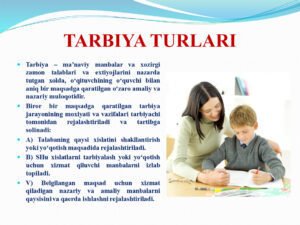SHARE WITH FRIENDS:
Moral and aesthetic education.
PLAN:
1. Concept of morality and moral education.
2. The content of moral education.
3. Aesthetic education and its content.
4. Means of aesthetic education.
"Basic" words and phrases for repeating the topic.
1. The content of moral education. Love for society, country, internationalism. Cultivation of moral attitude to cooking. Ethical attitude to people around. Discipline.
2. Aesthetic education. Aesthetic consciousness. Aesthetic. Perception. Aesthetic judgment. Aesthetic ideal. Aesthetic taste.
1. Means of aesthetic education. Nature. Art. Fiction. Music. Cinema. Theater. Painting. Sculpture. Graphics. Architecture.
Teaching in the higher education system is carried out with moral perfection of students. Their unity of mind and behavior is brought up. A person's attitude to the society and the country, to people, to people, can be checked as follows:
a) Cultivating love and loyalty to society and the Motherland,
This type of relationship is reflected in a person's patriotism, civic maturity, and international qualities, in his goals, in practical work aimed at increasing, consolidating and protecting the wealth of the Motherland.
Patriotism and internationalism work separately in moral education. It is not for nothing that it is said in Hadith Sharif that loving the country is a matter of faith.
b) Cultivating a moral attitude to purpose determines the whole moral direction of a person, because it is impossible to live without working and fighting.
This moral attitude is manifested in the high consciousness of a person, which is manifested in the process of meaning, in the understanding of the role of meaning in the verse, readiness for private and collective meaning, respect for meaning and devotion.
Students will develop the qualities of mutual support, joy of success, and a fair assessment of short and long-term interests through their participation in cultural activities.
c) Ethical attitude towards the surrounding people is putting the public, majority interest of the person above one's own interest.
The community helps in the formation of humaneness, attitude to charity, and conscious discipline in the student.
g) Educating the moral attitude of the person towards himself and his behavior is to teach the student to educate himself in the manner of self-discipline. Discipline is a moral norm that determines the civil image of a person.
Discipline is based on the mind, which is controlled by the will. Consistency, initiative, independence, self-restraint, and organization are will qualities that ensure conscious discipline. Conscious discipline rests with conscience and honesty.
Ethical relations are improved first in the family, in children's and children's homes, in schools and universities, and in community settings.
"... education," says Abdulla Avloni, "it is necessary to start from the day of birth, to energize our body, to enlighten our thoughts, to beautify our morals, to clarify our mind." Who does education? Where does he do it? This question should be answered first by home education." So, the writer is contributing to family education.
Aesthetic education includes the formation of aesthetic knowledge, skills and abilities in students, as well as the issue of education of aesthetic feelings, interest, needs, and evaluation.
Abdulla Avloni. "Turkish gulistan youd akhloq" Tashkent "Teacher" publishing house. 1992. Page 13
With the help of aesthetic education, students are able to understand the main criteria of beauty and ugliness, hope and desperation, tragedy and humor, learn to use their aesthetic skills and abilities in the verse, while getting acquainted with the surroundings, verses, natural scenes, works of art of various genres. must
Means of aesthetic education - in order to ensure the aesthetic development of students, life, nature, art aesthetics and artistic activity of young people, educational process selected from the environment are considered.
Family is the first school of beauty. Relationships of family members, home decorations, unity, harmony, orderly placement and neatness of these things directly affect the aesthetics of children.
Nature is the most important means of aesthetic education. Nature is the basis of various aesthetic experiences, and this basis depends on being impressed by nature, knowing it, hearing it.
In addition, the use of art forms, singing and music, and fiction literature as a tool in providing aesthetic education has a great significance. With the help of these tools, the students' color drawing, pencil drawing, sculpting, circle skills are formed, and with the help of music, musical ability, musical memory develops, and aesthetic taste grows. Literary literature encourages a deeper understanding of the verse, looking at the verse with a different perspective, as well as the aesthetic perception and aesthetic experiences become brighter in the literature classes, and of course, the ability of artistic speech increases.
